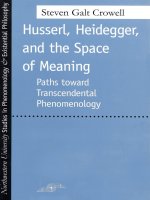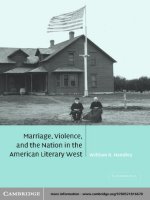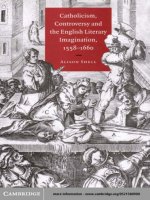0521830893 cambridge university press edith wharton and the politics of race oct 2004
Bạn đang xem bản rút gọn của tài liệu. Xem và tải ngay bản đầy đủ của tài liệu tại đây (1.2 MB, 240 trang )
This page intentionally left blank
E D I T H W H A RTO N A N D T H E P O L I T I C S
OF RACE
Edith Wharton feared that the “ill-bred,” foreign and poor would
overwhelm what was known as the American native elite. Drawing on
a range of turn-of-the-century social documents, unpublished archival
material and Wharton’s major novels, Jennie Kassanoff argues that
a fuller appreciation of American culture and democracy becomes
available through a sustained engagement with these controversial
views. She pursues her theme through Wharton’s spirited participation
in a variety of turn-of-the-century discourses – from euthanasia and
tourism to pragmatism and Native Americans – to produce a truly
interdisciplinary study of this major American writer. Kassanoff locates
Wharton squarely in the middle of the debates on race, class and
democratic pluralism at the turn of the twentieth century. Drawing
on diverse cultural materials, she offers close readings that will be of
interest to scholars of American literature and culture.
j e nni e a. ka s s a n o f f is Associate Professor of English at Barnard
College in New York. Her articles have appeared in Arizona Quarterly
and PMLA.
cambridge studies in american literature and culture
Editor
Ross Posnock, New York University
Founding editor
Albert Gelpi, Stanford University
Advisory board
Sacvan Bercovitch, Harvard University
Ronald Bush, St John’s College, Oxford University
Wai Chee Dimock, Yale University
Albert Gelpi, Stanford University
Gordon Hutner, University of Kentucky
Walter Benn Michaels, University of Illinois, Chicago
Kenneth Warren, University of Chicago
Recent books in this series
142. j oh n m C w i l l ia m s
Culture and Crisis in New England: Literature, Politics, History
141. su san m. g rif f in
Anti-Catholicism and Nineteenth-Century Fiction
140. rob e rt e . ab r a m s
Landscape and Ideology in American Renaissance Literature: Topographies
of Skepticism
139. j oh n d. k e rker in g
The Poetics of National Identity in Nineteenth-Century American Literature
138. m i c h e le b i rn b au m
Race, Work and Desire in American Literature, 1860–1930
137. r i c h ard g t u s in
Culture, Technology and the Creation of America’s National Parks
136. r alph b au e r
The Cultural Geography of Colonial American Literatures: Empire,
Travel, Modernity
135. mary e st eve
The Aesthetics and Politics of the Crowd in American Literature
134. pe t e r ston el ey
Consumerism and American Girls’ Literature, 1860–1940
133. e r i c h ar also n
Henry James and Queer Modernity
132. w i lli am r. ha n d l ey
Marriage, Violence, and the Nation in the American Literary West
131. w i lli am solo m o n
Literature, Amusement and Technology in the Great Depression
130. paul downes
Democracy, Revolution and Monarchism in Early Modern
American Literature
E D I T H W H A RTO N A N D
THE POLITICS OF RACE
JENNIE A. KASSANOFF
Cambridge, New York, Melbourne, Madrid, Cape Town, Singapore, São Paulo
Cambridge University Press
The Edinburgh Building, Cambridge , UK
Published in the United States of America by Cambridge University Press, New York
www.cambridge.org
Information on this title: www.cambridge.org/9780521830898
© Jennie A. Kassanoff 2004
This publication is in copyright. Subject to statutory exception and to the provision of
relevant collective licensing agreements, no reproduction of any part may take place
without the written permission of Cambridge University Press.
First published in print format 2004
-
-
---- eBook (EBL)
--- eBook (EBL)
-
-
---- hardback
--- hardback
Cambridge University Press has no responsibility for the persistence or accuracy of s
for external or third-party internet websites referred to in this publication, and does not
guarantee that any content on such websites is, or will remain, accurate or appropriate.
For my parents
Dorothy Jane Spitzberg Kassanoff
and
Arnold Howard Kassanoff
and for
Dan
Contents
Acknowledgements
page x
Introduction
1
1 Invaders and Aborigines: playing Indian in the Land of Letters
8
2 “The real Lily Bart”: staging race in The House of Mirth
37
3 “A close corporation”: the body and the machine in
The Fruit of the Tree
59
4 The Age of Experience: pragmatism, the Titanic and The Reef
83
5 Charity begins at home: Summer and the erotic tourist
112
6 Coda: The Age of Innocence and the Cesnola controversy
153
Notes
Bibliography
Index
166
193
214
ix
Acknowledgements
I felt that I was in great company and was glad.
Edith Wharton, 1934
This book focuses on one author, but it is not the study of one woman alone.
Instead, it is an inquiry into the constellation of people, places, ideas and
events that intersected to create the powerful writings of Edith Wharton. I
find this approach eminently suited to my own situation, for in writing this
book I have not been a single author. Rather, I have been at the crossroads
of a dynamic group of teachers, friends, institutions and experiences that
have alternately inspired, challenged, amused and enlightened me.
I have been the fortunate student of many extraordinary teachers. In
my home town of Dallas, Texas, Christine Eastus and Ray Buchanan at
the Greenhill School first introduced me to the pleasures and possibilities
of literary and historical study. As an undergraduate at Harvard, I was
privileged to work with Joseph A. Boone, Mary Carpentar, Sonya Michel
and Henry Moses, each of whom instilled in me an enthusiasm for letters
and learning. At Oxford, Kate Flint and John Bayley shared my interests in
Edith Wharton, and encouraged me to “do New York.” Their exemplary
generosity of mind was pivotal to my own growth as scholar.
As a doctoral candidate at Princeton, I had the great good fortune to work
with Maria Di Battista, Cathy N. Davidson, Diana Fuss, William Howarth,
Michael McKeon, Earl Miner, Lee Mitchell, Andrew Ross, Brenda Silver
and the late Lora Romero, each of whom modeled that important balance
between innovative scholarship and caring pedagogy. I owe a particularly
vibrant debt of thanks to Elaine Showalter, who has been an exemplary
teacher, mentor and friend. Not only is Elaine a ground-breaking critic, a
dynamic professor and a committed public intellectual, but she is also a
superb matchmaker.
At Barnard and Columbia, I have found a dynamic and supportive
group of friends and colleagues. I want to thank Rachel Adams, Jim Basker,
x
Acknowledgements
xi
Elizabeth Dalton, Pat Denison, Peggy Ellsberg, Gretchen Gertzina, Mary
Gordon, Maire Jaanus, Paula Loscocco, Monica Miller, Remington
Patterson, Caryl Phillips, Cary Plotkin, Quandra Prettyman, Maura
Spiegel, Timea Szell and Liz Weinstock for their companionship, encouragement and good humor. I am particularly indebted to my colleagues
Christopher Baswell, Lisa Gordis, Ross Hamilton, Peter Platt, Anne Lake
Prescott, Bill Sharpe, Herb Sloane, Margaret Vandenburg, and the members
of the 1998 Willen Seminar in American Studies for their willingness to read
portions of this book and for their many thoughtful and detailed suggestions
along the way. My conversations with a number of colleagues and friends
have considerably enriched my thinking about this project. Thanks to John
Gruesser, Martha Hodes, Alan Price, Augusta Rohrbach, Carol SchafferKoros and Martin White for their interest and support. Finally, I would like
to thank my students at Barnard and Columbia for perpetually keeping me
on my toes. I am especially grateful to Rachel Abramowitz, Alice Boone,
Emily McKenna and Taranee Wangsatorntanakhun for their expert research
assistance.
Several institutions have provided crucial financial and scholarly support for this project. I wish to thank the Rotary Foundation of America,
the English Department of Princeton University, Radcliffe College (now
the Radcliffe Institute for Advanced Study at Harvard University), the
American Philosophical Society, Barnard College, the Lilly Library of
Indiana University, and the Gilder Lehrman Foundation for their generous
funding. I would also like to thank the helpful archivists and librarians
at the Beinecke Rare Book and Manuscript Library at Yale University,
the Bodleian Library at Oxford University, the Butler Library at Columbia
University, the Firestone Library at Princeton University, the Lilly Library at
Indiana University, the Villa I Tatti of Harvard University and the Barnard
College Library. Portions of this book have appeared elsewhere in earlier
forms. Chapter 2 is reprinted by permission of the Regents of The University
of Arizona from Arizona Quarterly 53.1 (1997). An earlier version of
Chapter 1 appeared in PMLA 115 (Jan. 2000). Edith Wharton’s unpublished letters and writings are reprinted here by permission of the Estate of
Edith Wharton and the Watkins/Loomis Agency. I am grateful to the Yale
Collection of American Literature, Beinecke Rare Book and Manuscript
Library, Yale University, for permission to use their photograph of Edith
Wharton for the cover of this book.
The readers and editors at Cambridge University Press have taken this
project from mere manuscript to book. I have profited immensely from their
suggestions, and I appreciate not only their keen eye for detail, but also their
xii
Acknowledgements
commitment to the broader outlines of this project. I wish, in particular,
to thank Frances Brown for her meticulous and witty copy-editing, Jackie
Warren for her care in shepherding a rookie through the process, Ray Ryan
for his encouragement and ready support and Ross Posnock for his early
interest in my work.
To Rita Bowen, John Lloyd Brown, Jonathan Cordell, Laura Fenster,
Lola Mae Fields, Christine Fry, Patricia Krantz, Joyce MacDuff, Lynn
McLanahan, Kevin O’Hare and Kyra Terrano I owe a profound and
ongoing debt of thanks that they alone can fully appreciate. My friends
Jessika Hegewisch Auerbach, Jonathan Auerbach, Dana Becker-Dunn,
Brian Dunn and Astrid Guttmann have consistently made sure that I never
lacked for a pinch-hitter research assistant, a well-timed glass of wine, a
riotous onslaught of small children or a thoughtful friend. Thanks, you
guys.
Finally, I would like to thank my family for the love, encouragement,
patience and enthusiasm that have been my mainstay over the years. I am
grateful to all of the Browns, Kassanoffs, Peretzs, Schulmans, Spitzbergs,
Stones, Weinfelds, Wolfs and Woodcocks who have cheered me on, and
who have even secretly read a Wharton novel or two – just to see what I was
up to. Special thanks goes to my inner circle – Jim and Stephanie Kassanoff,
Ben and Sharon Kassanoff, Jordan and Marla Kassanoff, Joel and Nancy
Schulman, Logan Schulman and Ruth and Mel Schulman – whose love, wit
and support have grounded me over the years. My grandmother, Florence
Wolf Spitzberg Leonard has not only supported my love of learning, but
has also made sure that the hair was always out of my eyes, and that
my more controversial decisions were received with love – even when it
meant opting for a Macintosh computer over a debut at the Tyler Texas
Rose Festival. Above all, I want to thank my parents for their love and
encouragement. They have been my proofreaders, cheerleaders, traveling
companions, advisors and friends. I am more grateful to them than they
will ever know.
Although this book is sorely lacking in the way of broom-flying wizards
and underpant-clad superheroes, my children Molly Schulman and Jake
Schulman have been my own sources of magic and courage. Their curiosity,
energy and enthusiasm inform every page of this enterprise.
Finally, my deepest thanks go to Dan Schulman – my confidante, soulmate, jester and best friend. He alone knows the full measure of my love.
Introduction
The study of Edith Wharton’s politics raises a number of challenges for
the feminist scholar. Unlike Ezra Pound, whose conservatism has, in recent
years, stimulated a wealth of critical controversy, Wharton’s pedigree –
her upbringing in a fashionable New York family of Dutch and English
origin – has given many license to see her conservatism as a birthright,
and her politics as less a site of deliberate forethought than a consequence
of elite inheritance. Although Pound’s dramatic espousal of “a virulently
anti-democratic and elite egoism” has, in the words of Cary Wolfe, forced
contemporary critics “either to bury or to praise” him, Wharton’s conservatism, until now, has stimulated little critical attention (Wolfe 26). Indeed,
many critics have taken a don’t-ask-don’t-tell approach to Wharton’s conservatism. Even when her politics are faintly acknowledged, Frederick Wegener
remarks, they tend to be “either neutrally presented and illustrated, or awkwardly defused, or reconceived on some more agreeable basis” (“Form” 134).
In consequence, Wharton has become the May Welland of American letters. Like the genteel but underrated bride in The Age of Innocence (1920),
she has been mistaken for a na¨ıve and cosseted socialite, “so incapable of
growth, that the world of her youth had fallen into pieces and rebuilt itself
without her ever being conscious of the change” (Wharton, The Age of
Innocence 290).
In a 1989 interview, R. W. B. and Nancy Lewis, the editors of Wharton’s
collected letters, were asked whether their editorial choices had been influenced by a desire “to protect Wharton in any way.” The Lewises conceded
that yes, on some level, their selections had been influenced by such factors.
Recalling their publisher’s warning that a letter with racist or anti-Semitic
content “would over-shadow all the others in the media,” they concluded
that “it would be wrong to include an atypical letter that could distort the
public view of Wharton” (Bendixen 1). However well intentioned, this protective impulse highlights a central and longstanding problem in Wharton
criticism. Since 1921, when Vernon L. Parrington dismissed Wharton as a
1
2
Edith Wharton and the Politics of Race
“literary aristocrat” who was preoccupied with “rich nobodies,” Wharton’s
conservative politics have been treated as an obstacle to literary analysis
(Parrington 153). According to Robert Morss Lovett, an early critic, Wharton’s “conception of class [was] limited”; she was a writer for whom “The
background of the human mass is barely perceptible through the high windows, and the immense rumor of the collective human voice is muffled
by thick curtains” (Lovett 76). The complexities of American democratic
politics had no place in such mannered settings. In the words of Irving
Howe, “Mrs. Wharton had not a gift for the large and ‘open’ narrative
forms . . . which in modern fiction have been employed to depict large
areas of national experience” (4).
These assumptions bear witness to a widespread tendency in American
criticism to oversimplify and patronize conservative politics. Among progressive literary critics in our own period, conservatism has been the straw
man of choice, a flimsy opponent easily dismantled by the sophisticated
instruments of liberal democratic thought. While recent scholars have readily probed the restive impulses that animate the socially oppositional writings of Mark Twain, W. E. B. DuBois, Stephen Crane and Nella Larsen, they
have been less willing to acknowledge political and expressive complexity
in the work of those whose ideas they do not share.
Edith Wharton forces us to confront a number of basic blind spots in
American criticism. Her work calls into question some of our least contested
assumptions about the relationship between social class, literary production
and gender identity. If Wharton’s politics have been understood as so innate
that they do not warrant critical analysis, it is because this premise itself is
grounded in a limited conception of gender and class. Such assumptions
imply not only that the principles of American conservatism are always
already self-evident, but also that a patrician woman would have no reason
to mobilize her conservative ideology with the same deliberate forethought
that we have come to expect from writers like Wyndham Lewis, George
Santayana or Henry James. And the circumstances surrounding Wharton’s
re-entry into the American literary canon since the 1970s have only reinforced these impulses. Because renewed interest in Wharton criticism coincided with the ground-breaking impact of feminist scholarship, critics have
been loathe to scrutinize her politics too closely. While Amy Kaplan and
Nancy Bentley have discerningly acknowledged the role of class in such
novels as The House of Mirth (1905) and The Custom of the Country (1913),
other historically minded critics have all but ignored the cultural content
of Wharton’s major writings. Dale Bauer, for example, has argued that
Wharton’s early writings have “a strict preoccupation with form” – this
despite Bauer’s own richly interdisciplinary readings of Wharton’s later
Introduction
3
fictions (xiii). Novels like Ethan Frome (1911) and The Reef (1912), Bauer
insists, are best served by a “way of reading . . . first developed out of
the New Critical model” (xii). In relegating Wharton’s most widely read
texts to the margins of cultural analysis, Bauer concurs with Walter Benn
Michaels, who sweepingly claims in Our Country that “The major writers of
the Progressive period – London, Dreiser, Wharton – were comparatively
indifferent to questions of both racial and national identity.”1
For her part, Wharton would have balked at the suggestion that her
writings were immune to the dissonance of modern experience. Repeatedly
rejecting the “kind of innocence . . . that seals the mind against imagination
and the heart against experience,” she condemned the impulse to police
“the public view” of an artist as noxious (Age of Innocence 123). Early stories
like “The Muse’s Tragedy,” “The Portrait” and “The Angel at the Grave”
all register her cynical opinion of the reverential votary who scrupulously
patrols the factitious image of some late great creative genius. From Wharton’s standpoint, more interesting material lay in “regions perilous, dark and
yet lit with mysterious fires, just outside the world of copy-book axioms,
and the old obediences that were in my blood” (A Backward Glance 25).
Blood, I will show, is a central and complex Kate Chopin signifier in
Wharton’s work, as it is in the work of Pauline Hopkins, and William
Faulkner. Profoundly invested in the interconnected logic of race, class
and national identity, Wharton’s early fiction articulates a host of early
twentieth-century white patrician anxieties: that the ill-bred, the foreign and the poor would overwhelm the native elite; that American culture would fall victim to the “vulgar” tastes of the masses; and that the
country’s oligarchy would fail to reproduce itself and thereby commit
“race suicide.” In this regard, Wharton shared the turn of the century’s
expansive conception of race. Unlike today’s observers, who often narrowly
construe race as an exclusive matter of skin color, Wharton’s generation
applied the term liberally to a diverse array of possible identifications.
Henry James, for example, noted in 1879 that Nathaniel Hawthorne was
“by race of the clearest Puritan strain,” while Thorstein Veblen, the sociologist and economist, confidently declared in 1899 that “canons of taste are
race habits” (H. James, Hawthorne 12; Veblen 240). The settlement house
pioneer Jane Addams embraced general humanity when she noted that
“at least half of the race” was in need of social services; yet in nearly the
same breath, Addams invoked specific notions of ethnicity and nationality
when arguing that many disadvantaged Chicagoans were “held apart by
differences of race and language” (Addams 98). As the novelist and historian Henry Adams dryly observed in 1918, despite the fact that “no one
yet could tell [. . . him] what race was, or how it should be known,” the
4
Edith Wharton and the Politics of Race
concept itself was indispensable. Without race, Adams declared, “history
was a nursery tale” (Education 411–12).
Despite its often ferociously reductive effects, race, as a causal agent in
turn-of-the-century American social rhetoric, proved to have an expansive
and curiously elastic range. This most disputed term could refer to anything
from national origin, religious affiliation and aesthetic predilection, to geographic location, class membership and ancestral descent. In expressing her
own concerns about America’s future, Wharton drew freely on these protean possibilities. Although Wharton was not alone in making such claims
(Henry Adams, Sarah Orne Jewett and Theodore Roosevelt expressed similar concerns), her unique position as a best-selling writer and a respected
literary figure made her one of the most potent voices of her time. While
Wharton could elicit passionate responses from everyday readers (as in the
case of a woman who sent her a two-cent stamp and begged her to allow
The House of Mirth’s Lily Bart to live happily ever after with Lawrence
Selden), she could equally inspire the admiration of her highbrow literary
peers (R. W. B. Lewis 152). T. S. Eliot, for one, declared Wharton “the
satirist’s satirist,” while Pound solicited her to write for the Little Review.2
Wharton’s readiness to engage in the heated cultural debates of her time
may account for her diverse appeal. Her writings draw on a constellation
of discourses, from the mundane to the sublime. She once remarked that
“Every artist works, like the Gobelins weavers, on the wrong side of the
tapestry” (A Backward Glance 197). In this sense, my methodology reveals
my desire to take Wharton at her word – to follow her, that is, to the
other side of the loom where the knotted and frayed cultural threads of
her historical moment are interwoven. This study follows these discursive
strands dialectically from their place within the text to their position outside
of the work of fiction in order to formulate and explain their cumulative
role within the novel itself. By taking Wharton’s pre-war fiction as both my
starting point and my destination, I examine not only the role of race and
class in Wharton’s fiction, but also the extent to which Wharton’s writings
registered and, in some instances, shaped the larger patterns of American
cultural discourse in the early twentieth century.
In seeking to account for Wharton’s conservative place within the framework of American politics and culture, I have been compelled to describe a
political and historical position not my own. This necessity, however, has
forced me to identify and defend certain core scholarly principles that my
close engagement with Wharton’s conservatism has brought to the fore. We
need to evaluate Wharton’s work on its own terms, unconstrained by either
well-meaning protectionism or patronizing neglect. With this approach,
we can better see how Wharton’s resistance to popular culture and mass
Introduction
5
politics highlights not only the ongoing role of dissent in the United States,
but also the unformulated and at times tenuous nature of America’s multiethnic and multi-racial experiment. In seeking to critique and contain the
vox populi, novels like The House of Mirth (1905) and Summer (1917) remind
us afresh of the radical nature of the democratic project. Indeed, we ignore
Wharton’s conservative opinions at our own peril. By overlooking what
we do not wish to see, we risk not only whitewashing the complexity
of American cultural politics, but also underestimating the forceful arguments that drove writers like Edward Bellamy, Frances E. W. Harper, Upton
Sinclair and Charlotte Perkins Gilman to respond.
I begin my exploration of this unfamiliar terrain by examining Wharton’s
role in the construction of certain basic American mythologies about race
and national origin. “Invaders and Aborigines: playing Indian in the Land of
Letters” examines Wharton’s curious – and surprisingly various – comments
on aboriginal identity. When The Custom of the Country’s Ralph Marvell
identifies himself as an “aborigine” and his parvenu wife Undine as an
“invader,” he participates in a longstanding American practice of “playing
Indian” that dates back to the Boston Tea Party. Although by the early twentieth century Native Americans had become synonymous with anti-modern
simplicity and indigenous authenticity in the minds of many Americans of
white European descent, the practice of masquerading as an Indian revealed
the opposite possibility – that American identity was nothing more than a
minstrel act. In a nation whose equivocal origins were mired in the indeterminacies of colonialism, slavery and western expansion, the danger of
confusing an imitative identity with the real thing had a peculiarly visceral import. Wharton responded to the possibilities of racial and ethnic
hybridity by forging a racial aesthetic – a theory of language and literature that encoded a deeply conservative, and indeed essentialist, model of
American citizenship. If her native land generously welcomed the world’s
huddled masses, then the novel, under Wharton’s neo-nativist laws of “pure
English” and her colonial determination to suppress “pure anarchy in fiction,” formed an architectural, aesthetic and political bulwark against the
menacing possibilities of democratic pluralism (The Writing of Fiction 14).
Wharton puts this racial aesthetic into literary practice in The House of
Mirth, her first best-selling novel. Faced with imminent Anglo-Saxon doom,
Lily Bart sacrifices herself on the altar of racial purity and eugenic perfection.
Chapter 2 examines how Lily’s aestheticized decline functions as both a
tragic extinguishment and a demographic climax: Lily’s death, I suggest,
simultaneously marks the annihilation of a rare, endangered species, and a
stylized act of preservation. Wharton’s heroine becomes a version of Carl
Akeley’s idealized taxidermic tableaux in the American Museum of Natural
6
Edith Wharton and the Politics of Race
History. Captured and immobilized at the peak of racial achievement, she
embodies a stylized alternative to a slow decline in New York’s competitive
racial wilderness.
Like The House of Mirth, its successor, The Fruit of the Tree (1907), circulates around the prone, immobilized body of an elite American woman.
After a paralyzing equestrian accident, Bessy Amherst, a wealthy mill
heiress, falls prey to the impassive mechanisms of modern medicine. Her
comatose body, plied with repeated rounds of stimulants and narcotics,
incarnates what, for Wharton, was the nightmarish loss of upper-class
agency. In this sense, The Fruit of the Tree, the subject of chapter 3, explores
the threat posed by machine culture to the traditions of class entitlement.
Only a merciful act of euthanasia at the hands of a well-meaning and
well-born nurse can restore Bessy’s imperiled agency. In marked contrast to
Mattie Silver, the working-class victim of Ethan Frome’s climactic sledding
accident, Bessy escapes the torture of a living death only through a singular
act of elite compassion.
If technology represented one threat to elite hegemony, then changing
sexual mores at the turn of the century posed another. In chapter 4, I suggest
that sexuality effectively democratized the Victorian body by subordinating
the mind’s authority to the commonplace impulses of passion. Sex, according to Wharton, put all Americans on a common plane, blurring distinctions of race and class. In The Reef (1912), Wharton explores the relationship
between the body human and the body politic, between the “regions
perilous” of sexual desire and the “unmapped region outside the pale of
the usual,” where the country’s other half dwelled (A Backward Glance 25).
In likening her heroine’s sexual awakening to a working-class rebellion,
Wharton shows how sexuality can topple the sacred abstractions of the
genteel tradition by unleashing the unwieldy chaos of direct experience.
In this respect, The Reef marks Wharton’s most immediate engagement
with the pragmatism of William James. Sophy Viner, the novel’s disruptive
American governess, wreaks havoc on the codes of class and race by having
an affair with her employer’s fianc´e. Like the H.M.S. Titanic, which sank
into the North Atlantic several months before the novel was published,
The Reef explores a comparable emotional shipwreck. Submerging class
distinctions in the turbid waters of direct experience, sexuality threatens to
sink everyone into a disastrously erotic democracy.
With the violent arrival of World War I, Wharton was forced to rethink
her brief flirtation with democracy. If The Reef revealed the egalitarian temptations of pure sensation, then Summer marked the revival of
Wharton’s most austere brand of conservatism. As she toured the battle lines
near Verdun, she saw countless French dwellings reduced to rubble, their
Introduction
7
private interiors brutally exposed to the pitiless sky. For Wharton, the shattered privacy of the roofless house came to epitomize the war’s uncanny
havoc. As I suggest in chapter 5, Summer represents Wharton’s concerted
effort to restore Europe’s wartime refugees, and indeed America itself, to
the conservative rites and rituals of the racially homogenous “old home.”
By engaging a number of contemporary discourses – from tourism and philanthropy to abortion and incest – Summer proposes a strategy of cultural
containment and racial restoration that seeks to repair the fissures wrought
by modern democracy.
In the years following the war, Wharton was forced to acknowledge
the failure of the recuperative strategy she had explored in Summer. If
The House of Mirth marked a monumental act of historic preservation,
then The Age of Innocence, its Pulitzer Prize-winning successor, conceded
the inevitability of elite defeat. As the novel’s adulterous lovers gaze at
Louis di Cesnola’s Cypriot antiquities in the Metropolitan Museum of Art,
they simultaneously recognize the hopelessness of their unconsummated
passion and the transience of America’s vanishing aristocracy. Someday,
Ellen Olenska speculates, Old New York will similarly be the stuff of an
antiquarian’s collection, its obsolete artifacts labeled “Use unknown” (258).
Despite its nostalgic poignancy, this moment, I argue in the coda, is a
quintessentially American one. Despite the lovers’ appeal to the museum’s
cultural authority, by the 1880s the Metropolitan had itself become a locus
of controversy and debate. Rumor had it that Cesnola’s artifacts were fakes.
Their display in the gallery set off a public commotion that was followed,
in turn, by a dramatic trial.
As her quiet allusions to the Cesnola controversy would seem to suggest,
Wharton deplored the instability of American identity. Railing against the
country’s hybrid origins, she formulated a critique of American democracy
that was as complicated as it was conservative. In exploring a number of
strategies to contain what she saw as the pluralist excesses of American life,
however, Wharton inadvertently profited from the cultural diversity she
was determined to resist. In drawing on the considerable cultural resources
of American popular discourse, Wharton gave her own fiction a hybrid
force that could withstand and even countermand the limiting hauteur of
her message. This pluralism, while a keen source of Whartonian anxiety,
remains of palpable concern for scholars today. By limiting the range of
critical inquiry, contemporary critics risk reifying a progressive genealogy
that celebrates the pursuit of diversity, while – ironically – marginalizing its
diverse opponents. To engage the complex conservatism of Edith Wharton
is to take a step toward addressing this problem by confronting American
pluralism in all of its manifestations.
chap t e r 1
Invaders and Aborigines: playing Indian in
the Land of Letters
Edith Wharton’s 1934 memoir, A Backward Glance, begins on a curious
note of historical rupture. Recalling the New York birthplace of her father,
George Frederic Jones, Wharton describes a “pretty country house with
classic pilasters and balustraded roof ” on land that eventually became East
Eighty-first Street. Although the original dwelling has long since disappeared, an heirloom print shows a columned residence with “a low-studded
log-cabin adjoining it under the elms” (17). According to family legend, the
rustic cabin was actually the “aboriginal Jones habitation,” and its colonnaded neighbor a later addition. Wharton, however, doubts the veracity of
this account. The log cabin was not, in all likelihood, the family’s ancestral
seat, she remarks; it was “more probably the slaves’ quarters” (18).
The rapidity with which this picture of Yankee self-reliance dissolves
into its uncanny double – a repressed portrait of African enslavement –
is as breathtaking as it is blunt. For all of its Lincolnian connotations,
the Jones log cabin inexorably betrays the system of forced servitude that
sustained the Jones family’s economic, social and political ascent.1 Indeed,
Wharton’s account betrays what Susan Scheckel calls “the fundamental
ambivalences of American national identity . . . the deep ambivalence
of a nation founded on the conceptual assertion of natural right and the
actual denial of . . . natural rights” to Indians, African Americans and
women (14). Despite the prescient observation of Mariana Griswold van
Rensselaer, a nineteenth-century critic who remarked that “nothing . . . save
the wigwam of the North and the pueblo of the South” could be a truly
American home (19), Wharton craved a site of political, social and racial
legitimacy that could offset the country’s hybrid, disingenuous origins.
Unlike France, the country of Wharton’s “chosen peoplehood,” America
was Europe’s derivative step-child, itself both a subject and an agent of
domestic conquest (Sollors 128). This dichotomy was vividly encoded in
the Jones home, whose classic pilasters testified to its share in “the great
general inheritance of Western culture,” and whose slave quarters bore
8
Invaders and Aborigines
9
witness to the moral ambiguity and racial pluralism of American origins
(French Ways 96).2
Wharton’s preoccupation with her country’s beginnings were symptomatic of a wider set of anxieties at the turn of the twentieth century.
At a time when even Warren G. Harding, then candidate for President,
was rumored to have “black blood,” America’s fixation on the lurking
possibility of “invisible blackness” made race a site of national hysteria
(Williamson 106). As Eric Sundquist notes, by the mid-1890s America had
begun its headlong “rush toward racial extremism in law, in science, and
in literature.” By abridging the equal protection guarantees afforded under
the Constitution, state and federal courts sought to “render the African
American population invisible or, what was more fantastic, to define color
itself not by optical laws but by tendentious genetic theories that reached
metaphysically into a lost ancestral world” (228). The “crisis in the loss of
distinction” that ensued is evident in a letter from Wharton to her editor at
Charles Scribner’s Sons, William Crary Brownell, in 1902 (Sundquist 259).
Admitting that she “hate[d] to be photographed because the results are so
trying to my vanity,” Wharton nonetheless agreed to have a new publicity
photograph taken. “I would do anything to obliterate the Creole lady who
has been masquerading in the papers under my name for the last year.”3
The comment is at once self-mocking and oddly self-defining. Wharton no
doubt realized that the very methods of mass production that had made her
first novel, The Valley of Decision, a popular success in 1902 were spawning
a culture of imitation, replication and deception. Photography offered a
particularly vivid locus for this concern. Summarizing nineteenth-century
uncertainties about photography, Miles Orvell asks, could “the camera – a
mechanical instrument – . . . deliver a picture of reality that was truthful,”
and if so, “what was a ‘truthful’ picture of reality?” (85). What truth did
the Creole lady express? As a photograph put to the service of advertising and publicity, was it not doubly suspect, evoking the “carnivalesque
tradition” that, T. J. Jackson Lears suggests, “subverted unified meaning
and promoted the pursuit of success through persuasion, theatricality, and
outright trickery”? (Fables 212). The Creole lady, however, embodies additional instability within the discourse of race. As P. Gabrielle Foreman
has observed, while the camera was touted “as an antidote to illusion in
an increasingly unstable and unreadable mid-century America,” photography “also heightened ‘the problem of racial discernment’” by challenging
viewers’ assumptions about the phenotypic status of light-skinned African
Americans in photographs of the period (528). The Scribner’s publicity
shot had effectively transformed Wharton into an imitation white woman.
10
Edith Wharton and the Politics of Race
Undermining the guarantees of personal authenticity, mechanical reproduction transformed race into just another variable in the changeful algebra
of modernity.
Wharton found that American origins, like her own publicity photograph, were mired in a system of similarly fallible signs. Despite her longing for a more “subtle way of . . . indicating, allusively, [a nation’s] racial
point of view” (Uncollected Critical Writings 92), these distinctions in the
United States were difficult, if not impossible, to make. After all, America
was a country in which a genteel family’s “aboriginal habitation” could be
mistaken for the slave quarters. Under such circumstances, national origins
were uncertain at best.
Wharton saw her native land as “a world without traditions, without reverence, without stability,” a “whirling background of experiment” incompatible with racial purity. Like the declining New England town at the
center of Wharton’s 1908 short story “The Pretext,” Yankee life was disappearing and taking its quaintly “inflexible aversions and condemnations”
with it. Villages like Wentworth, and other “little expiring centers of prejudice and precedent [made] an irresistible appeal to those instincts for
which a democracy has neglected to provide” (Wharton, The Hermit and
the Wild Woman 152). America’s accommodating welcome to immigrants,
workers, feminists and newly minted millionaires had put an end to Yankee
rule. In the wake of the wildcat railroad strikes of 1877, the Haymarket
Square bombing in 1886, and the assassination of William McKinley by a
self-proclaimed anarchist in 1901, genteel Americans grew increasingly convinced that America was becoming “a society unhinged” (Wiebe 78). Josiah
Strong, a popular minister of the day, saw the “urban menace . . . multiplying
and focalizing the elements of anarchy and destruction” (qtd. in Boyer 131).
Looking down from his perch high above “the turmoil of Fifth Avenue,”
Henry Adams likewise compared New York to “Rome, under Diocletian.”
One was aware of “the anarchy, conscious of the compulsion, eager for the
solution, but unable to conceive whence the next impulse was to come or
how it was to act” (Education 499–500). Rupture – not connection – was
to be the twentieth century’s characteristic gesture. With the arrival of the
year 1900, “a new universe” had been born – one “which had no common
scale of measurement with the old.” In this “supersensual world,” Adams
could measure “nothing except by chance collisions of movements imperceptible to his senses, perhaps even imperceptible to his instruments, but
perceptible to each other” (Education 381–2). The scale, the pace and the
reach of modern America defied causal sequences; predictable trajectories
that had formerly connected origin to issue, and theory to practice, now
Invaders and Aborigines
11
seemed irrevocably broken. As a result, formerly powerful elites, outspent
and outvoted, cast about for a new source of self-justification. Gone was the
“egalitarian vision of citizenship” that, according to Eric Foner, had been
one of the legacies of the Civil War. In its place, Americans found themselves gravitating toward “definitions of American freedom based on race”
(Foner, Story 131). Race became the essentialist axis orienting the patriciate’s
nostalgia for civic cohesion, social exclusivity and oligarchic permanence.
dem ocracy and its d iscontents: t h e va l l e y
of decision
Like Josiah Strong and Henry Adams, Wharton saw early twentieth-century
America as a “floundering monster” (Backward Glance 379). Her countrymen, she said, lacked the “blind sense in the blood of its old racial power”
(Motor-Flight 178), for they had learned from their English forebears to
“flout tradition and break away from their own great inheritance” (French
Ways 97). The Valley of Decision captures this sense of loss and distress.
Though ostensibly a historical romance set in eighteenth-century Italy, The
Valley is in fact a sustained meditation on America itself. Despite Henry
James’s famous plea that Wharton turn her attention to “the American
subject” – “DO NEW YORK!” – The Valley is a profoundly American
book (Powers 34). The novel chronicles the rise and fall of Odo Valsecca, a
reform-minded aristocrat whose reign over the northern duchy of Pianura
collapses with the invasion of Napolean’s troops and the unleashing of
anarchy and class warfare. Suspended precariously between two historical
epochs, Italy and the United States both face a comparable choice: should
they align themselves with the decadent gentry, or embrace instead the
forces of mass culture and revolutionary democracy?
It was a choice with which Wharton was all too familiar. Like Fulvia
Vivaldi, The Valley’s intellectual heroine, Wharton saw herself the “child of
a new era, of the universal reaction against the falseness and egotism of the
old social code” (Valley 2: 217). On the one hand, she deplored the political
apathy that had prevented her own immediate ancestors from playing a
more significant role in affairs of state; on the other hand, however, she
scrupled at embracing a future that seemed so unlike her own genteel
past. The Valley of Decision explores this dilemma. Like the United States,
Wharton’s Italy is a “topsy-turvy land” whose aristocracy is soft and complacent, whose proletariat is explosive, and whose ascendant mercantile class
is distinctly untrustworthy (1: 148). A “fat commercial dulness” pervades
both countries, obstructing the development of “personal distinction which









